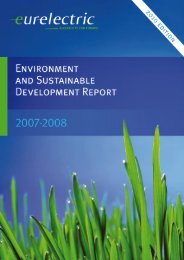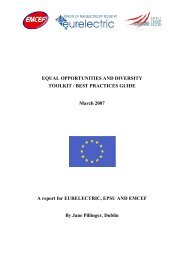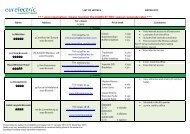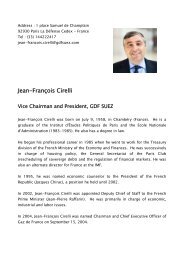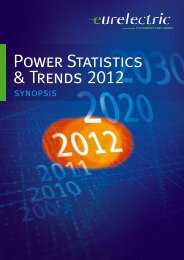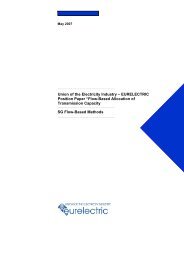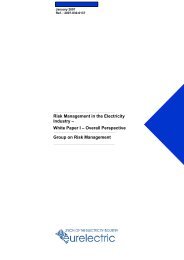Activity Report 2012 - Eurelectric
Activity Report 2012 - Eurelectric
Activity Report 2012 - Eurelectric
Create successful ePaper yourself
Turn your PDF publications into a flip-book with our unique Google optimized e-Paper software.
In May <strong>2012</strong>, the Executive Body of the UNECE<br />
Convention on Long-Range Transboundary Air<br />
Pollution adopted amendments to the 1999<br />
Gothenburg Protocol, a multi-pollutant protocol<br />
designed to reduce acidification, eutrophication<br />
and ground-level ozone. The revised protocol<br />
sets 2020 emission ceilings for sulphur dioxide,<br />
nitrogen oxides, volatile organic compounds,<br />
ammonia and particulate matter, which will be<br />
incorporated into the EU’s updated air quality<br />
policy in 2013. Richard Ballaman, who chaired<br />
the negotiations, explains the key outcomes.<br />
What are the key features of the revised Gothenburg<br />
Protocol?<br />
The 1999 Gothenburg Protocol is part of the UnECE<br />
Convention on Long-Range Transboundary Air Pollution<br />
(CLRTAP). The revision of the Protocol, adopted in May<br />
<strong>2012</strong>, addresses two key concerns.<br />
On the one hand, it updates technical requirements<br />
and emission reduction commitments beyond 2010.<br />
For instance, to reflect technical progress since 1999, it<br />
was necessary to update documents on best available<br />
techniques and mandatory emission limit values for<br />
stationary and mobile sources. Moreover the emission<br />
reduction objectives for 2020 are no longer expressed<br />
as absolute national ceilings, but are instead set as a<br />
percentage compared to a reference year (2005).<br />
On the other hand, the revision aims to facilitate access<br />
to the Protocol for the countries of Eastern Europe, the<br />
Caucasus and Central Asia.<br />
Air quality has improved over the past decades but it<br />
still remains an important issue in Europe and beyond.<br />
What do you think are the main challenges for future<br />
air policies?<br />
The decrease in sulfur dioxide (SO ) and nitrogen oxide<br />
2<br />
(nO ) emissions has significantly reduced acidification<br />
x<br />
of terrestrial and aquatic ecosystems. For instance,<br />
we can observe positive signs of biological recovery in<br />
Scandinavian lakes.<br />
interview<br />
Concentrations of fine particles in Europe<br />
largely exceed the recommended values<br />
However, there is still too much deposition of nitrogen<br />
compounds, resulting from excessive emissions of<br />
nitrogen oxides from combustion and ammonia losses<br />
in agriculture. Similarly, concentrations of fine particles<br />
in Europe largely exceed the values recommended by<br />
the World Health Organisation.<br />
As for tropospheric ozone, the importance of the<br />
transboundary dimension and the necessity to further<br />
reduce emissions from precursor gases are one of the<br />
major challenges for the revised Gothenburg Protocol.<br />
Tropospheric ozone and methane, as well as black carbon,<br />
are short-lived climate pollutants whose emissions must<br />
be reduced to improve air quality and public health as<br />
well as to mitigate climate change.<br />
EURELECTRIC has been a long-time Un observer,<br />
including to the negotiations on the Gothenburg Protocol.<br />
What do nGos, and industry associations such as<br />
EURELECTRIC in particular, bring to the debate?<br />
The active participation of industry associations is<br />
particularly appreciated in expert groups such as the<br />
Expert Group on Techno-Economic Issues where best<br />
available techniques and associated emission limit values<br />
are established. Their participation is also very useful<br />
in the Task Force on Integrated Assessment Modelling,<br />
which develops emission reduction scenarios based on<br />
the implementation of cost-effective measures.<br />
Finally, associations with an observer status are welcome<br />
during the negotiations taking place in the Working Group<br />
on Strategies and Review and then in the Executive Body:<br />
they ensure transparency in the decision-making process<br />
and facilitate the communication of the negotiation<br />
outcome and later the implementation of the Protocol<br />
at national level.<br />
Richard BALLAMAN is Chair of the Working Group on<br />
Strategies and Review under the UNECE Convention on<br />
Long-Range Transboundary Air Pollution.<br />
43



